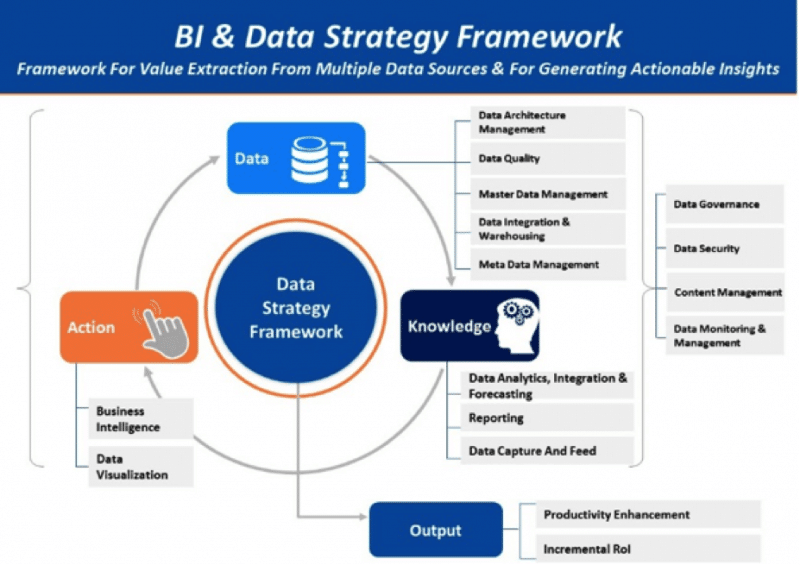You can have data without information, but you cannot have information without data. – Daniel Keys Moran

Data has become the engine oil for every company, and analytics the combustion engine. In order to exploit the true potential of data, it is imperative for organizations to understand the value data brings to the table and how it can help drive insightful decision-making in countless business activities.
Often companies want to move into the Big Data deployment phase but face pitfalls as they get stranded in one phase or another. The main reason behind the struggle is due to the absence of BI and data management strategy in place and thus many companies struggle to move beyond big data strategy “on paper” to completing the full big data lifecycle
In every company, data should be the cornerstone of strategy, as it ultimately helps in moving from Big Data planning to actual deployment.
Master Data Management: Creating a BI and Data Strategy Framework

To make your data talk and drive your business to a new realm of potential, it is essential for companies to chalk out an enterprise data management strategy that studies data holistically and brings out relevant insights.
To create a data strategy framework, you need relevant, complete, accurate, timely, consistent, meaningful, and usable data so that final output leads to productivity enhancements and incremental ROI.
The Foundation of the Three-Pronged Approach
When developing a data management strategy that is going to inform business decisions while integrating smoothly with business processes, it’s important to look at the overarching framework from three different angles:
• What systems and technologies need to be in place
• What improvements can be made to existing processes
• What organizational roles effect and are affected by data change

Any plan that fails to take into consideration the systems, processes, and human resources who manage and use the data fails to truly represent that organization.
1: Deploying the Right Technology
The first angle in this trifecta-type approach is technology. Without taking a look at how technology bogs down processes and teams, it’s not possible to get a good grasp on where an organization can improve.
It’s necessary to evaluate the platforms on the market, introduce new solutions, and enhance existing tools.
Here are some of the tools a given enterprise will likely require to achieve end goals:
Data Mining Tools. What’s the point of data if it can’t be used? Data mining tools detect and extract information and patterns from large data sets, thus transforming it into insightful metrics. Some commonly used data mining tools are R, SAS, KXEN, etc.
ETL Tools. Most business processes require consistency. When it comes to big data, you don’t want to have to request an extraction of information every time you need it. Instead, the process of extracting, transforming, and loading data (ETL) can be automated so that the data is regularly migrating and integrating without manual commands.
Enterprise Data Warehouse. One of the most integral pieces of an overall data strategy framework is a centralized data warehouse, one that can store and integrate data from a variety of sources. Especially where customer account data is associated, it’s important to have various systems communicating so that your overview of a single customer (or any unit of interest) is fully connected.
Enterprise Monitoring Tools. For added security and quality assurance, critical environments can be continuously monitored for a variety of problems. Using a monitoring tool that is built in to your existing framework ensures fast diagnoses and seamless notifications.
BI & Reporting. How can an organization use best practices for knowledge share when it comes to big data? Keeping only the necessary team members inside of a big data platform doesn’t mean that only those few team members get to access the information. Instead, business intelligence reporting tools can help break down powerful data for different roles and uses.
Analytics Tools. The core task of an analytics tool is tasked is giving a user highly specific information. Whether your users need customer acquisition data or product life cycle tracking, it’s imperative to seek out tools that will integrate with critical environments to deliver necessary information in user-friendly interfaces.
2: Implementing the Right Processes
While we’re busy at our jobs, data is busy too. Before it can reach your screen in a crisp PDF report, it has to go through various processes.
When setting up a data management strategy, you can’t only think of the technologies, but of the processes that will join technology and people together. What actions can be consolidated into one platform? What actions will compete against each other?
All of these questions (and more, of course) come into place with common data processing phases like:
• Data consolidation
• Data assessment
• Quality analysis
• Common data models
• Data analytics
This is the level at which quality becomes so critical. Key stakeholders in different divisions of an organization can help inform a data management strategy in terms of process documentation, existing quality controls, and the methods that are already adopted.
During this part of data management strategizing, potential risks can be discovered and mitigated.
3: Setting Up the Right Team
An intelligent data management strategy is never just about the tools. It’s also about the people.
Based on necessary process and technology improvements, organizational structures are also up for change. Who is going to manage and monitor the overarching data systems and processes?
The data strategy team plays a crucial role in the global ecosystem of the organization and makes a number of key contributions. Continuous monitoring and data validation is achieved by a mixture of automation and manual processes, and dependent on the size of the organization (and the size of the data sets), these tasks could require a full team of data stewards.
A data governance team or singular role can help ensure data entry stands are met, that errors are resolved, and that data stewards are validating data based on pre-defined standards and methods.
Data security also requires the work of a knowledgeable team. And as for data analytics, anyone who’s ever been deemed the in-house expert on a particular platform knows what it’s like to be bombarded with requests for reports or help from other team members. Creating a designated team to provide the necessary insights to other divisions of the organization can be a huge step forward when it comes not only productivity but data management ROI.
The key goal for any effective data management strategy is to empower an organization with critical insights.
To be successful—and have maximum impact—business intelligence and data management strategies rely on the right technologies, processes, and teams to deliver true value and impact the bottom line.












